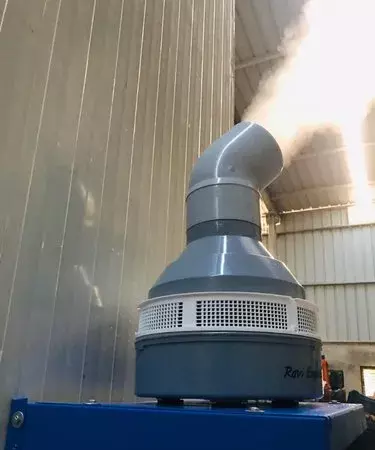
Humidification is an important part in controlling the pressroom climate. Pressroom humidification involves maintaining the correct amount of moisture in the air to avoid static electricity buildup, limit paper shrinkage, and create the perfect environment for ink transfer. In this blog we’ll discuss the need for humidification in the Pressroom.
Pressroom humidification is the process of adding moisture to the air in a printing environment to maintain a specific humidity level. Humidity refers to the amount of water vapour present in the air, and it is measured in terms of relative humidity (RH). Relative humidity is expressed as a percentage and represents the amount of moisture in the air compared to the maximum amount of moisture the air can hold at a particular temperature.
In pressrooms, a perfectr elative humidity level ranges from 45% to 60%. This range varies depending on the printing process, paper used, and climatic conditions.
One of the primary benefits of pressroom humidification is
its positive impact on print quality. When the air in the pressroom is too dry, it can lead to static electricity buildup on the paper sheets. This static electricity can cause the paper to misfeed, jam, or stick together, leading to printing errors and decreased productivity. By adding moisture to the air, humidification systems help neutralise static electricity, ensuring smoother paper feed and improving overall print quality.
Proper humidification helps prevent paper shrinkage. Paper is hygroscopic, meaning it naturally absorbs or releases moisture to equilibrate with the surrounding environment. When the air is too dry, the paper loses moisture and shrinks, affecting its dimensions and causing registration problems during printing. By maintaining optimal humidity levels, humidification minimises paper shrinkage, ensuring precise alignment and crisp, consistent prints.
Humidification also plays a vital role in optimising ink transfer and drying processes. In printing, the moisture content of the paper affects how well the ink adheres to the surface and dries. When the paper is too dry, it can absorb moisture from the ink, causing the ink to dry slowly or unevenly, resulting in smudging or set-off (ink transfer to the opposite side of the sheet).
Pressroom humidification helps maintain the proper moisture balance in the paper, allowing for better ink adhesion and faster drying times. This results in sharper images, reduced ink consumption, and decreased drying time requirements, leading to increased productivity and cost savings.
Extended Equipment Lifespan
The benefits of humidification extend beyond print quality and process improvements. Maintaining optimal humidity levels can also help protect sensitive printing equipment. In dry conditions, static electricity discharge can damage electronic components and lead to costly repairs or replacements. By neutralising static, humidification systems help safeguard expensive machinery, extend their lifespan, and reduce downtime due to equipment malfunctions.
Seasonal Variations:Humidity levels can fluctuate significantly with changing seasons, making it challenging to maintain consistent conditions throughout the year.
Commercial humidification systems are used to achieve and maintain the perfect humidity levels in pressrooms. These devices are designed to add moisture to the air in a controlled and effective manner.
Adiabatic Systems:Adiabatic humidifiers use a high-pressure pump to create a fine mist of water that evaporates into the air, adding moisture without significantly raising the air temperature. These systems are energy-efficient and can humidify large spaces effectively.
Steam Humidifiers:Steam humidifiers boil water to create steam, which is then introduced into the air through a distribution system. These systems provide precise humidity control and are often used in smaller pressrooms or areas where higher temperatures are not a concern.
Ultrasonic Humidifiers:Ultrasonic humidifiers use high-frequency sound waves to vibrate a water source, creating a cool mist that evaporates into the air. These systems are quiet and can be used in spaces requiring low noise levels.
Monitor Humidity Levels: Regularly monitor humidity levels in the pressroom using hygrometers to ensure they remain within the optimal range for printing operations.
Invest in Humidification Systems:Consider investing in humidification systems that are suitable for pressroom environments, taking into account factors such as capacity, efficiency, and compatibility with printing equipment.
Maintain Equipment: Regularly maintain and calibrate humidification systems to ensure they function effectively and efficiently, helping to avoid downtime and costly repairs.
Train Staff: Educate pressroom staff on the importance of humidity control and how it impacts printing operations, encouraging them to be vigilant in monitoring and maintaining humidity levels.
Conclusion
Pressroom humidification is essential to making good printing conditions. Humidification systems increase print quality and productivity by controlling static electricity,
reducing paper shrinkage, and improving ink transfer and drying. The advantages of humidification go beyond the printing process, since suitable humidity levels help safeguard sensitive equipment from static electricity harm.
We at Hydrofogger.com provide a vast range of humidifiers depending on your needs.
Stay updated with the latest news, tips, and exclusive offers by subscribing to our newsletter! Join our community to receive valuable insights directly in your inbox. Don't miss out—sign up today and enhance your experience with us!